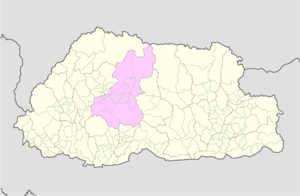Wangdue Phodrang District facts for kids

Wangdue Phodrang District is one of the 20 districts in the amazing country of Bhutan. It's located in the central part of Bhutan, known for its stunning mountains, deep valleys, and peaceful rivers. The main town and administrative center of this district is called Wangdue Phodrang. This area is famous for its rich history and beautiful natural scenery, making it a special place to visit and learn about Bhutanese culture.
Contents
Exploring Wangdue Phodrang
Wangdue Phodrang District is a large area with diverse landscapes, from high mountains to lower valleys. It's a place where you can see traditional Bhutanese life and beautiful nature. The district is home to many important cultural sites, including ancient temples and monasteries.
Village Blocks (Gewogs)
The district is divided into smaller areas called gewogs, which are like village blocks or sub-districts. There are 15 of these gewogs in Wangdue Phodrang District, each with its own unique communities and traditions. These gewogs help organize the local government and services for the people living there.
Here are the 15 village blocks:
- Athang Gewog
- Bjena Gewog
- Daga Gewog
- Dangchu Gewog
- Gangte Gewog
- Gasetsho Gom Gewog
- Gasetsho Om Gewog
- Kazhi Gewog
- Nahi Gewog
- Nyisho Gewog
- Phangyuel Gewog
- Phobji Gewog
- Ruepisa Gewog
- Sephu Gewog
- Thedtsho Gewog
The Famous Wangdue Phodrang Dzong
One of the most important landmarks in the district was the historic Wangdue Phodrang Dzong. A dzong is a type of fortress monastery found in Bhutan. It serves as both a religious center and an administrative hub. The original Wangdue Phodrang Dzong was built in 1638 by the founder of Bhutan, Zhabdrung Ngawang Namgyal. It was strategically placed on a ridge overlooking the Punatsangchhu and Dangchhu rivers.
Sadly, the original dzong was destroyed by a fire in 2012. However, the people of Bhutan, with help from many supporters, have been working hard to rebuild it. This shows the strong spirit and dedication of the Bhutanese people to preserve their heritage. The rebuilding project is a massive effort to bring this important historical site back to life.
Nature and Wildlife
Wangdue Phodrang District is also known for its beautiful natural environment. It includes parts of the Jigme Dorji National Park, which is one of Bhutan's largest protected areas. This park is home to a wide variety of plants and animals, including rare species like the snow leopard, takin (Bhutan's national animal), and red panda.
The district's diverse landscapes, from high-altitude alpine meadows to lush forests, provide habitats for many different types of wildlife. Conservation efforts are very important here to protect these precious ecosystems and the animals that live in them.
Culture and Festivals
Like other parts of Bhutan, Wangdue Phodrang District celebrates many vibrant festivals, known as Tshechus. These festivals are held annually at the dzong and other monasteries. They are important religious events where people gather to watch masked dances, receive blessings, and socialize. The dances often tell stories from Buddhist history and folklore.
These festivals are a wonderful way to experience the rich culture and traditions of Bhutan. They are colorful, lively, and full of spiritual meaning for the local communities.
Images for kids
See also
 In Spanish: Distrito de Wangdue Phodrang para niños
In Spanish: Distrito de Wangdue Phodrang para niños



